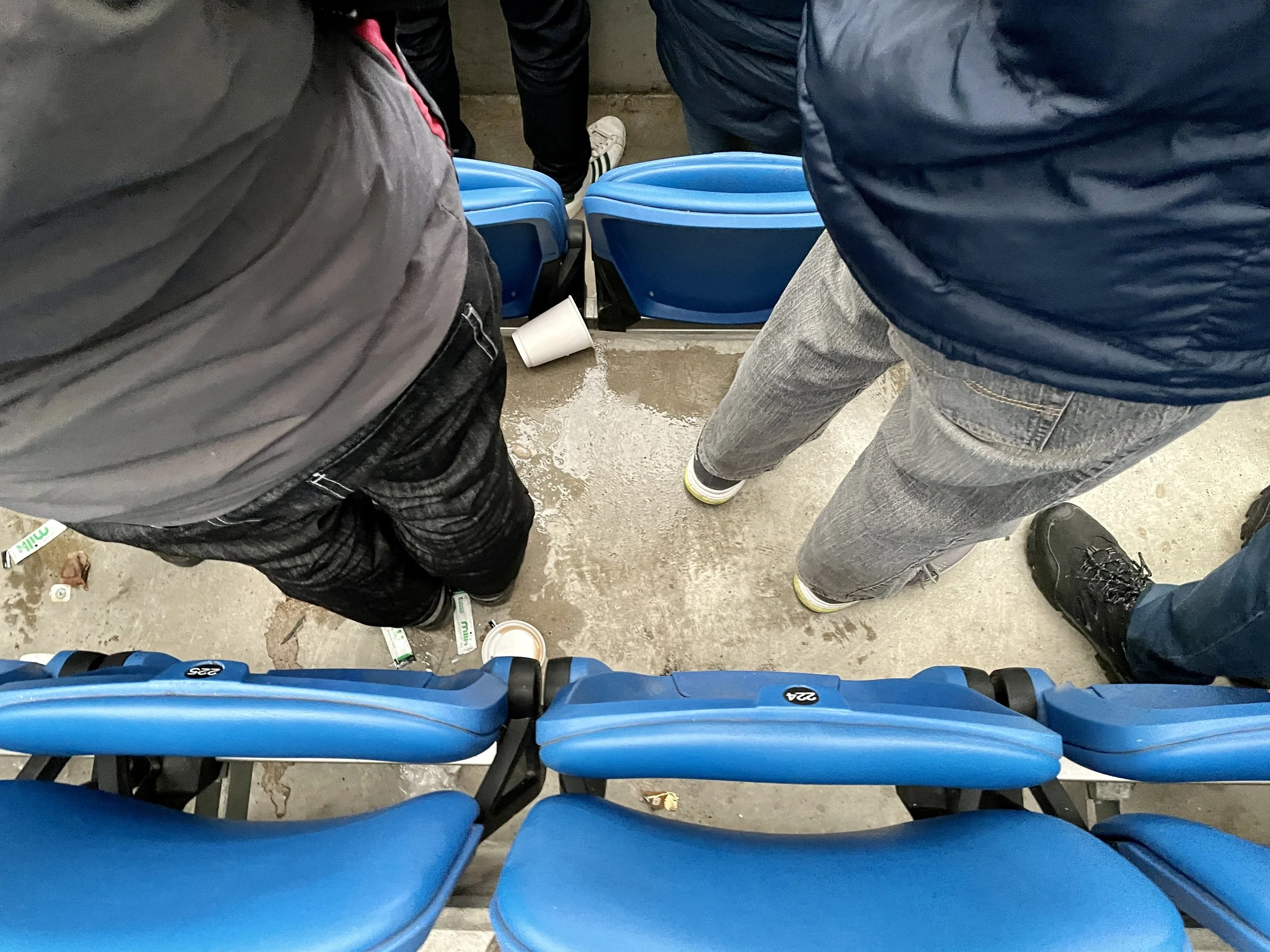Safe standing: a view from the North
Is safe standing the answer to any atmosphere-related woes?
To first consider this question, let’s start by taking a look back. Standing in view of football was outlawed at stadia within the top two tiers of English and Welsh football through the Football Spectators Act 1998, introduced following ‘Lord’ Justice Taylor’s inquiry into the deaths of 97 Liverpool supporters in the Hillsborough disaster (JF97).
The years that followed saw football fandom gentrified with one of the key drivers being clubs’ ability to charge more for a seat than the equivalent place on a terrace.
Between 1989 and 1999, topflight football tickets increased by 312%, in a period when the retail price index increased by 54.8%*. By 2014 there were reports that some like-for-like ticket prices had risen by 1,150%.
https://historyandpolicy.org
Fast forward to October 2016 and safe standing was high on the football media agenda. But despite some positive sounding pronouncements, football clubs remained on the fence (it was stated at one point that 'safe standing could become a ghetto that alienates people').
The Albion disclosed that they didn’t want to upset the local Safety Advisory group (who grant safety licences for sporting stadia). They were concerned that a strong show of Albion support for the issue might affect their relationships with the various authorities and government departments. They saw Brighton’s active fans getting organised and highlighting the wider issues as an unhelpful protest, and whilst communication remained open, it felt more like a one-way correspondence.
In the spirit of cooperation, a North Stand tifo (note, not protesting) on safe standing was pulled at the last minute.
A safe standing forum was organised - by the club - for later in the same month, although the turnout was lower than expected. Even the temptations and delights of a South Stand lounge bar didn’t boost attendance. Most people there were in favour… although you might expect that, considering the people attending had given up their time on a Thursday night to discuss the issue.
It was all sounding too good to be true and so it proved.
We were quickly brought back to reality as we learnt that the ‘safe’ standing model the club were examining was one-space-per-ticket. Very much like how the current informal standing-by-your-designated-seat system works.
We were quickly brought back to reality as we learnt that the ‘safe’ standing model the club were examining was one-space-per-ticket. Very much like how the current informal standing-by-your-designated-seat system works. It’s standing, yes, and there’s a bar in front of you, but it’s nothing like the terraces you find in European stadiums.
Many people quote Germany as being the ideal template, and in fact our very own CEO Paul Barber OBE (PB) travelled there to see how it’s done. But it’s very different in Germany. There’s proper terracing, not what safe standing looks like here in the UK. The terrace has its own rules around who goes where. Spectators can drink in full view of the pitch (including during the game, if they want) and are generally treated like adult citizens of their state. People generally get to the ground very early to secure their spot and prepare their tifos, and enjoy themselves as much as you might at a gig or festival.
But the atmosphere can be better in stadiums in Germany primarily due to the fact that the fans are organised. They’re listening to each other, working together, with many of them dedicating as much time to organising and leading the atmosphere as they are to watching the game, many taking their lead from an organised ultras group.
The club have also suggested in the past that introducing safe standing just at the back few rows of the North Stand might be an option. Which would have minimal to no impact on the atmosphere.
In 2018 a nationwide petition on safe standing received 112,000 supporting signatures triggering a discussion in parliament.
Police chiefs at the time warned that a return to standing could lead to missiles being thrown, hate chanting and that families (for families read ‘women’, and feel free to check the police’s record of looking after women) wouldn’t want to go into those areas of the ground. Ridiculous and out of touch would be many peoples’ first thoughts.
Club surveys on safe standing have offered fans the option of suggesting the best areas. They have also introduced the question of where the money for converting existing seats into safe standing might come from. Which was a sign of where some of the clubs’ concerns lay. Crowdfunding was suggested… a bit like the concept of asking working people to pay for austerity.
For additional context, standing on terraces was not banned in stadiums hosting other top-level sporting fixtures - rugby league being one example - attracting significant crowds, who have continued to stand on terraces to this day.
Is safe standing ever likely at the Albion?
PB has stated that if we were to implement safe standing it would reduce the capacity, and therefore would increase costs without increasing revenue “without any obvious return” (Barber’s own words, our quotation marks).
Club owners and boards see this issue in terms of costs vs benefits. And Brighton appear to see this as a potentially risky investment, supposedly benefiting only a small number of fans and coming at the cost and detriment to other more “inclusive” initiatives.
PB confirmed that the club’s authorities “tolerate” (Barber’s own word, and his quotation marks) standing in the back rows of the North Stand. He went on to state that a ‘pizza slice’ solution - safe standing in the NW corner - was not a possibility as it would impede sightlines for fans sitting either side of this area. Clearly anyone with a functioning protractor could (as the kids say) ‘literally’ dismiss this as untrue.
The underlying message from the club appears to remain that atmosphere and noise can be created with little or no change to the configuration of the stadium, and they cite the atmosphere at games such as the Man City and Man U home victories, and the Euro 2022 fixtures, as evidence.
Let’s just agree, our stadium is for all, and both club and fans should do everything we can to make sure that anyone who wants in, gets in.
Another theme in the discussions on safe standing is inclusion. Let’s just agree, our stadium is for all, and both club and fans should do everything we can to make sure that anyone who wants in, gets in.
But within the ‘one club’ happy family, it can’t be denied that we are all different, with fans enjoying the game in markedly different ways. This difference should also be catered for, so if you prefer to stand, you should be able to, as long as it doesn’t impede others’ enjoyment.
According to some commentators ‘families’ (for ‘families’ read women and children) can’t possibly be expected to stand. The insinuation being that women and children don’t enjoy being in rowdy and passionate sporting crowds. Which is just such obvious bollocks that it doesn’t merit any further comment.
An argument for
Whilst it’s great that the atmosphere is being discussed and options being considered, we can’t just look at German football culture and hand pick the bits we like, hoping they’ll be a panacea. On their own those elements won’t have the desired impact.
Singers being spread across the back of the North Stand in three main groups (under the screen, behind the goal, and in the NW corner) demonstrates clearly the problems of having active singing fans spread thinly across one large stand.
Take a look at any fan group in the football world and 99% have a block (occupying back to front of that block) from where noise and singing starts. Whilst Brightonians (and Hovians, Sussaxons) actively love to do our own thing - we wun’t be druv - when it comes to crowd dynamics, and the laws of sound waves spreading, we’re pretty sure we need to look to the 99%.
Our view is that the biggest impact of implementing safe standing would be the movement of like-minded people into one single area.
Our view is that the biggest impact of implementing safe standing would be the movement of like-minded people into one single area. At the moment, the club’s initial tolerance of standing on the back rows has spread our singing element out across a long thin line. Queue several different songs happening at once, or the same song happening at different speeds.
The recent revelation that there’s “no interest in safe standing” (mentioned by a FAB member on a We Are Brighton blog post) feels like PB is hiding behind his CP Company goggles. On top of this, the suggestion that safe standing will impact the player budget feels at odds with the club’s decision to spend money on a wine & cheese pitch-side wank tunnel. Investments for the corporates: just vote yes. Investments to benefit fan culture and people in the North Stand: just say no. Just remember, dear fans, how much this is going to cost you, because you can’t afford it… a tactic straight out of the Tories election playbook.le
Safe standing might not be for all, but if you look beyond your own goggles and disregard the government-esque electioneering tactics and police posturing, you’ll see a number of positive benefits if we’re ever given a whole block of safe standing. Front to back.
Yes, it’s not a cure-all, but introduced with proper support from the club, and with full consultation, despite its limitations, the introduction of safe standing will bring three main benefits.
It’ll help to reintegrate our disparate groups of singers currently spread across the back of the North Stand. It will reduce unnecessary conflict (wishful thinking) with the stewards, so their time and energy can be better spent elsewhere assisting those in actual need.
And it would create a space for people who want to stand (your fellow Albion fans and friends, let’s remember) and to build atmosphere and co-ordinate from.
This article was originally published in Dogma Issue 9, April 2023 and has been amended slightly for publication here.






